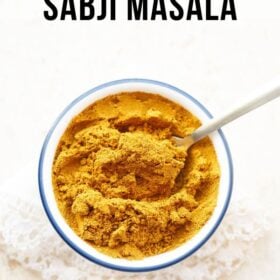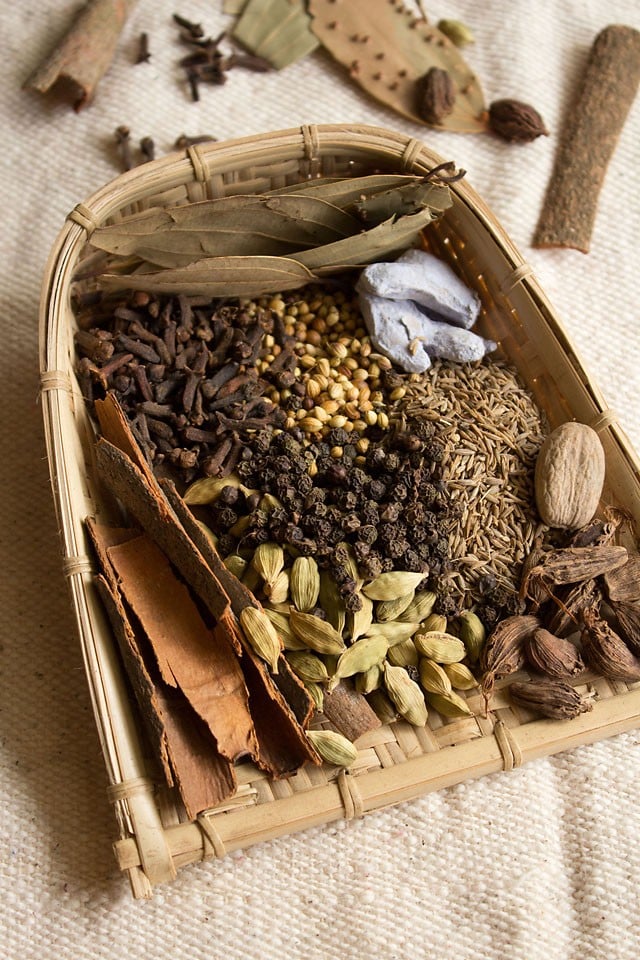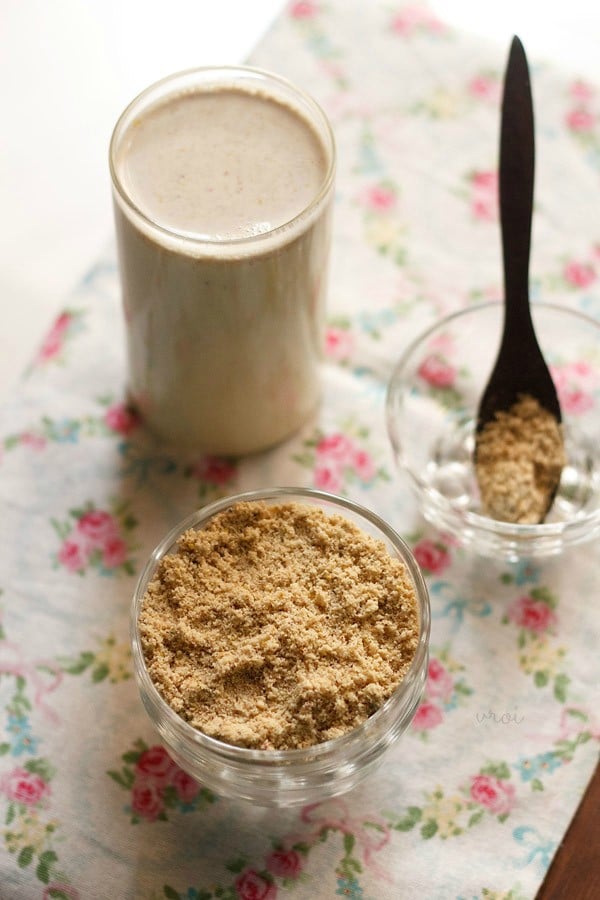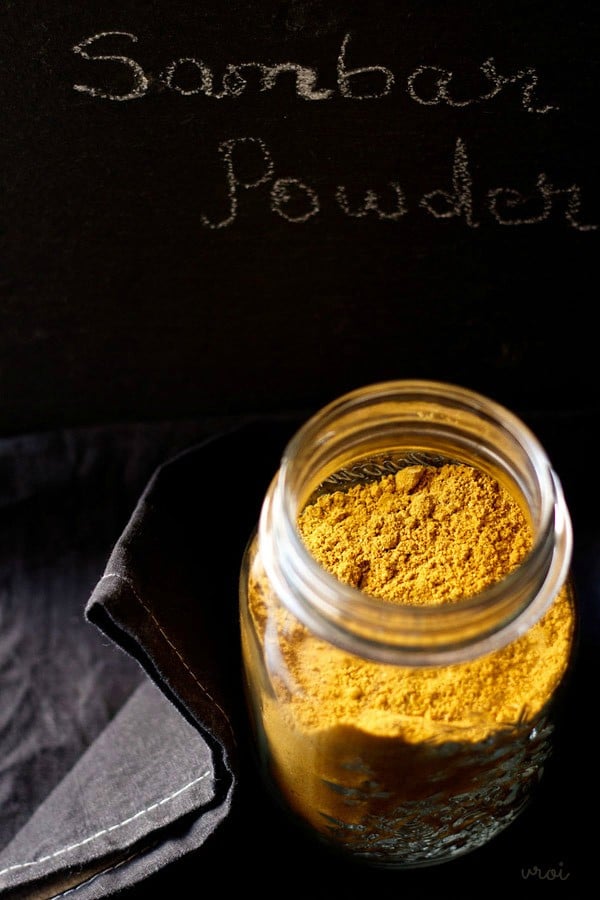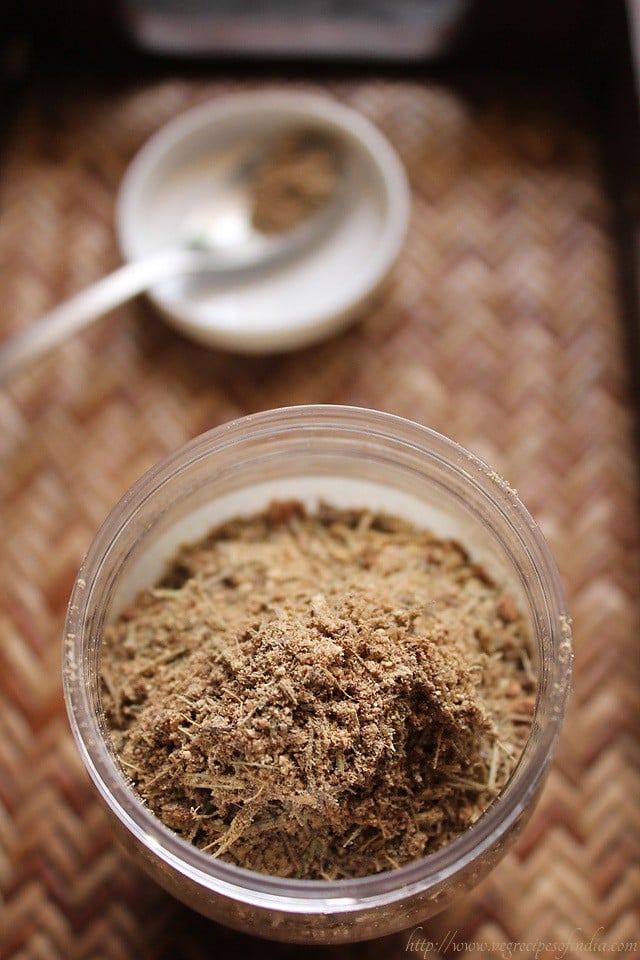Sabji Masala – How to Make And Use
Everyday Indian cooking often relies on one simple trick which is the right masala blend. This homemade Sabji Masala gives that signature North Indian aroma and warmth to everyday vegetable dishes. It is a balanced spice mix that works beautifully in both dry and gravy-based sabzis. The flavors are gentle yet deep, making it ideal for daily meals as well as special family recipes.
Homemade Sabji Masala Recipe
Sabji (or sabzi) means a cooked vegetable dish, while masala refers to a blend of spices. Sabji Masala is a versatile North Indian spice mix used to flavor everyday vegetable dishes, paneer gravies, lentils, and dry sabzis.
Sabji Masala is made with commonly used whole and ground spices in Indian cooking, that are roasted gently to bring out their natural aroma and flavor. A mix of tangy, warm, and slightly sweet notes gives this masala its balance and depth.
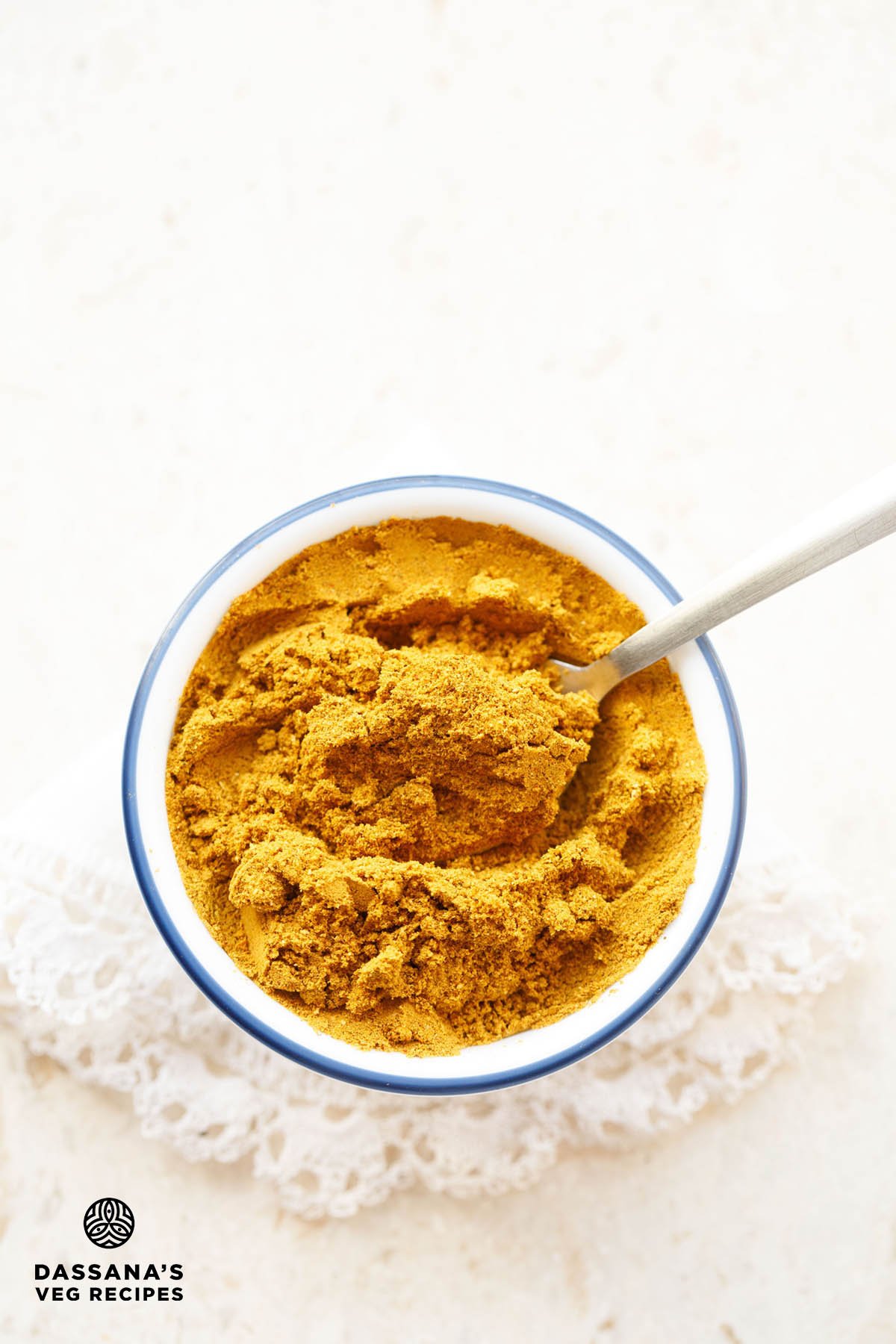
This blend gives your dishes a restaurant-style depth without being overpowering. In everyday Indian cooking, we often reach for Garam Masala, but it can sometimes feel too intense or heavy for certain dishes.
Having a few different spice blends like Kitchen King Masala, Curry Powder, Sabji Masala, or Garam Masala in your pantry lets you adjust flavors based on the recipe.
When you want a masala that’s full of aroma and warmth but not too strong, Sabji Masala is the best choice. It adds depth like garam masala yet keeps the flavors balanced and rounded. Use it in any curry or dry vegetable dish when you want something flavorful but not overwhelming.
Making your own masala powder at home ensures freshness, quality, and consistency. No additives, no fillers, no preservatives but just pure whole spices roasted and ground the way you like.
Once you start using your own homemade Sabzi Masala, you’ll rarely reach for the store-bought packets again.
This aromatic blend brings depth, balance, and warmth to everyday Indian sabzis and other dishes. Each spice plays its part; while some add heat, others sweetness or tang, and together they create that familiar North Indian flavor many of us love.
Whole Spices Used
Coriander and cumin build the earthy base of this Sabji Masala spice blend. Fennel adds a gentle sweetness, while cloves, caraway, and cardamoms bring depth and aroma.
Cinnamon, tej patta, and mace lend warmth and a hint of freshness. Mustard and black pepper add mild pungency, and Kashmiri red chillies give color and light heat.
If you don’t have Kashmiri red chillies, feel free to use any dry red chilli variety that’s low to medium in heat.
Adjust the amount depending on how spicy or pungent the chillies are. Add less for mild heat or a bit more if you prefer a stronger kick.
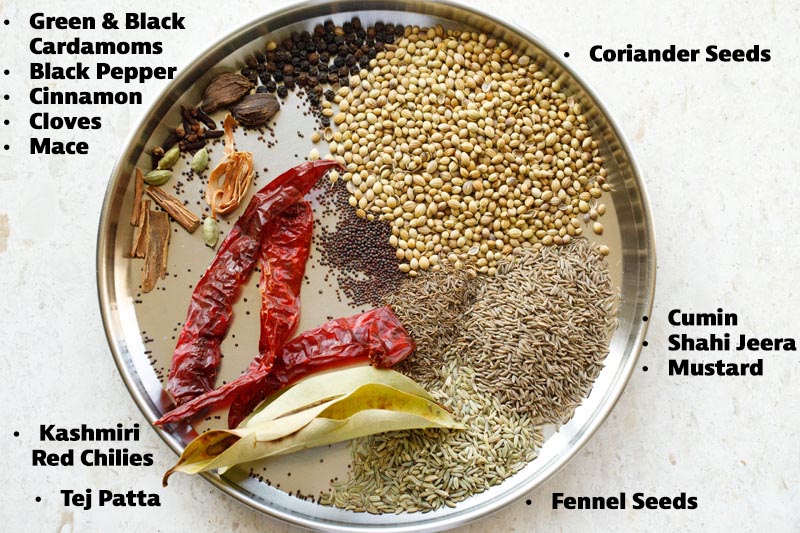
Ground Spices You’ll Need
Dry ginger and turmeric infuse warmth and golden color. Dry mango powder (amchur) brings a light tang that brightens the masala.
Asafoetida adds savory balance, and pink salt enhances all the flavors. Nutmeg gives soft sweetness, while garlic powder, if used, adds an extra aromatic touch.
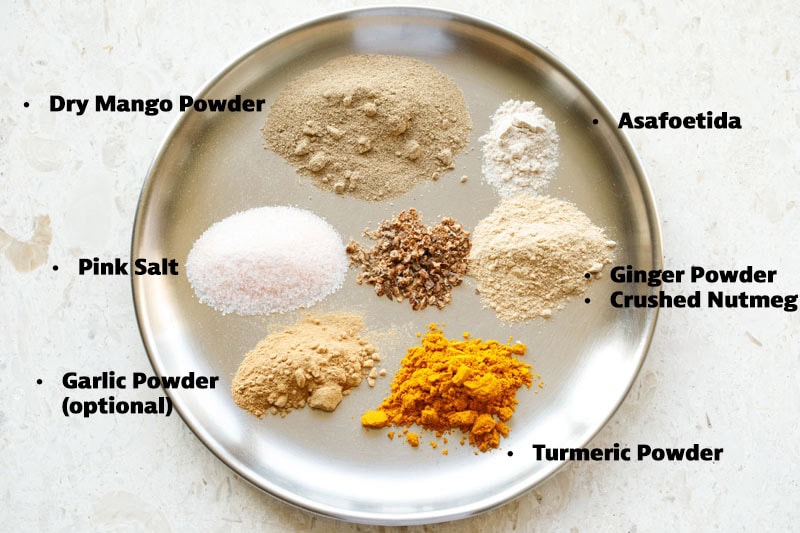
When the spices come together, they form a well-rounded masala that fits easily into everyday cooking. It brings out the natural taste of vegetables and adds gentle warmth without overpowering the dish.
You can also try making other Indian spice blends at home to suit different recipes and regional flavors.
More Homemade Indian Spice Mixes To Try
Chai Masala
Sambar Masala
Pav Bhaji Masala
Chaat Masala
Biryani Masala
How to Make Sabji Masala
Making Sabji Masala at home is simple and rewarding. You only need whole and ground spices that are commonly found in Indian kitchens.
Roasting the spices releases their essential oils and enhances their aroma, giving the masala its rich, balanced flavor.
You can adjust the heat level to suit your taste, and even skip stronger spices like mace or black cardamom for a milder version.
Roast The Whole Spices
1. First measure and set all the whole spices aside listed below. Additionally also measure and set aside the ground spices.
Heat a heavy kadai or a frying pan on low to medium-low heat. Keeping the heat to a low add all the spices.
- 4 tablespoons (20 grams) coriander seeds
- 2 tablespoons (14 grams) cumin seeds
- 1 teaspoon (3 grams) black peppercorns
- 1 tablespoon (7 grams) fennel seeds
- 6 cloves
- 4 green cardamoms
- 2 black cardamoms
- 2-inch cinnamon stick
- 2 tej patta
- 1 blade mace (javitri), optional
- 5 grams or 3 Kashmiri red chillies, seeds removed
- 1 teaspoon (2 grams) caraway seeds (shahi jeera)
- ½ teaspoon (2 grams) mustard seeds, optional
- ½ teaspoon crushed nutmeg
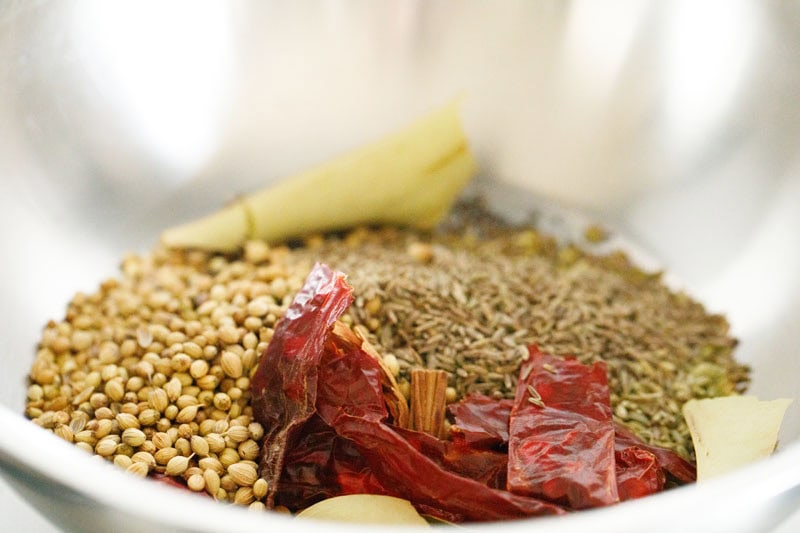
2. Dry roast stirring often over low to medium-low heat for 3 to 4 minutes until fragrant. Do not brown the spices and ensure that they don’t get burnt.
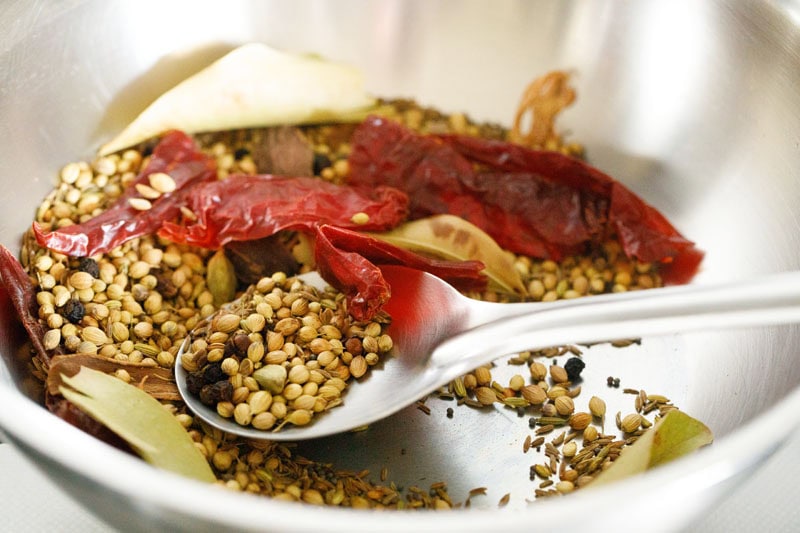
Add The Powdered Spices
3. Remove the pan from heat and place it on your kitchen countertop. While it’s still hot, add in the following ground spices:
- 1 teaspoon dry ginger powder (saunth)
- 2 teaspoons (4 grams) dry mango powder (amchur)
- 1 teaspoon (3 grams) turmeric powder
- ¼ teaspoon asafoetida (hing)
- 1 teaspoon dried garlic powder or flakes, optional
- 1 teaspoon (7 grams) pink salt or edible rock salt or regular salt
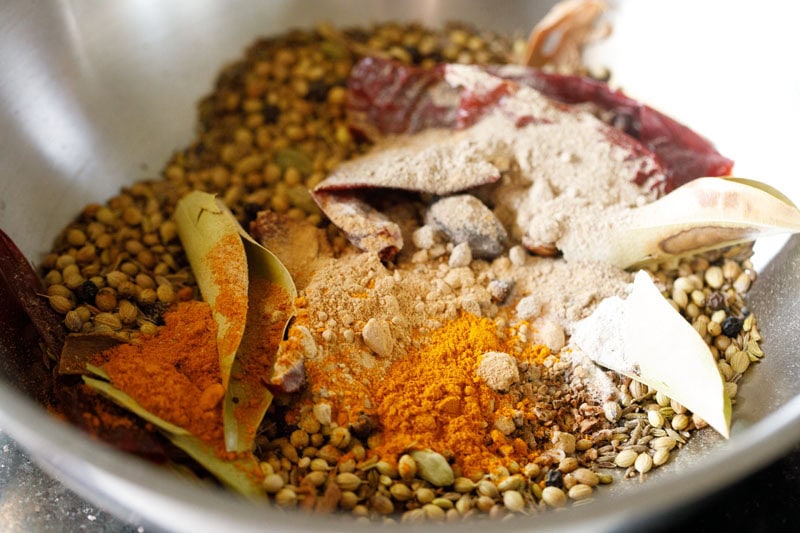
4. Mix thoroughly. The residual heat lightly toasts these spices for extra depth.
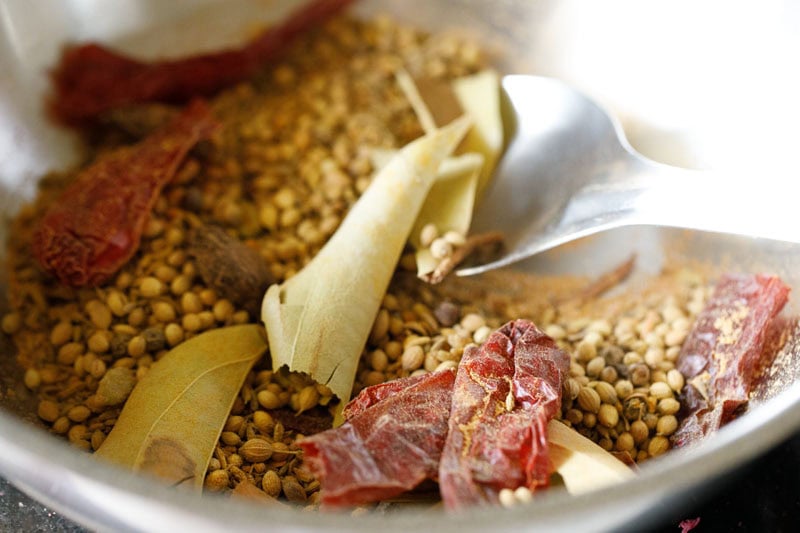
Make Sabji Masala
5. Let the mixture cool completely.
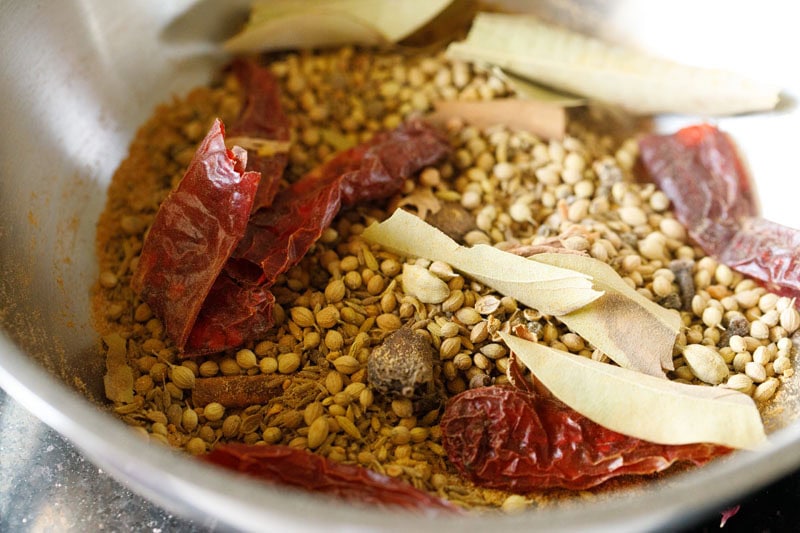
6. Once cooled, transfer the spices to a mixer-grinder, high-speed blender or a spice grinder. Grind in batches if you have a small equipment.
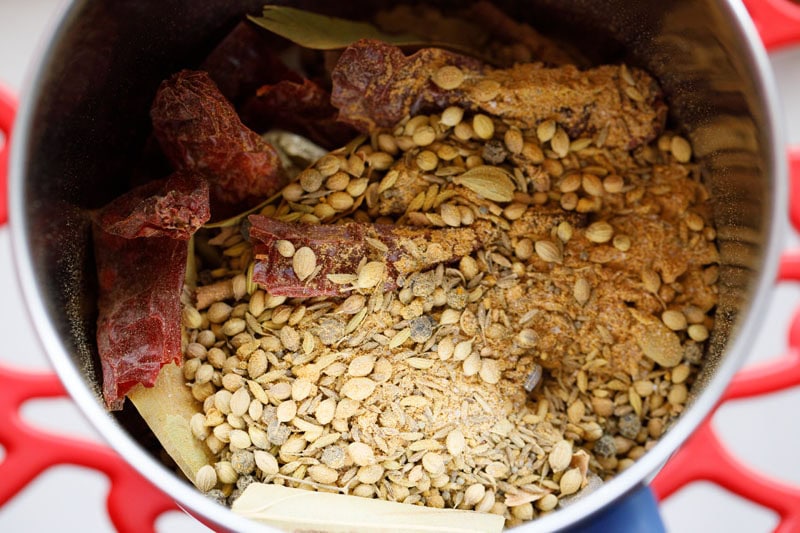
7. Grind the roasted spices to a fine powder.
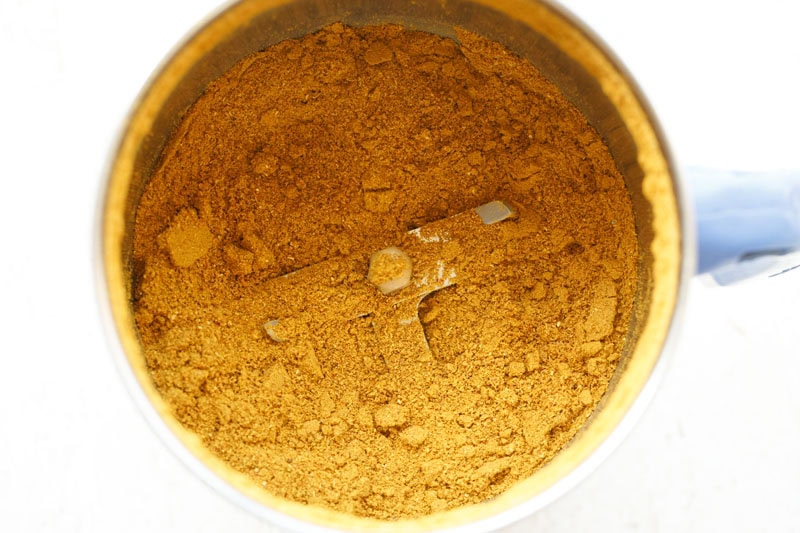
8. Transfer the freshly ground homemade Sabji Masala to a clean, dry glass jar. Keep in a cool, dark place. You can also store in the refrigerator.
This Sabji Masala stays fresh for up to 1 month and is best used within that time for optimal flavor and aroma.
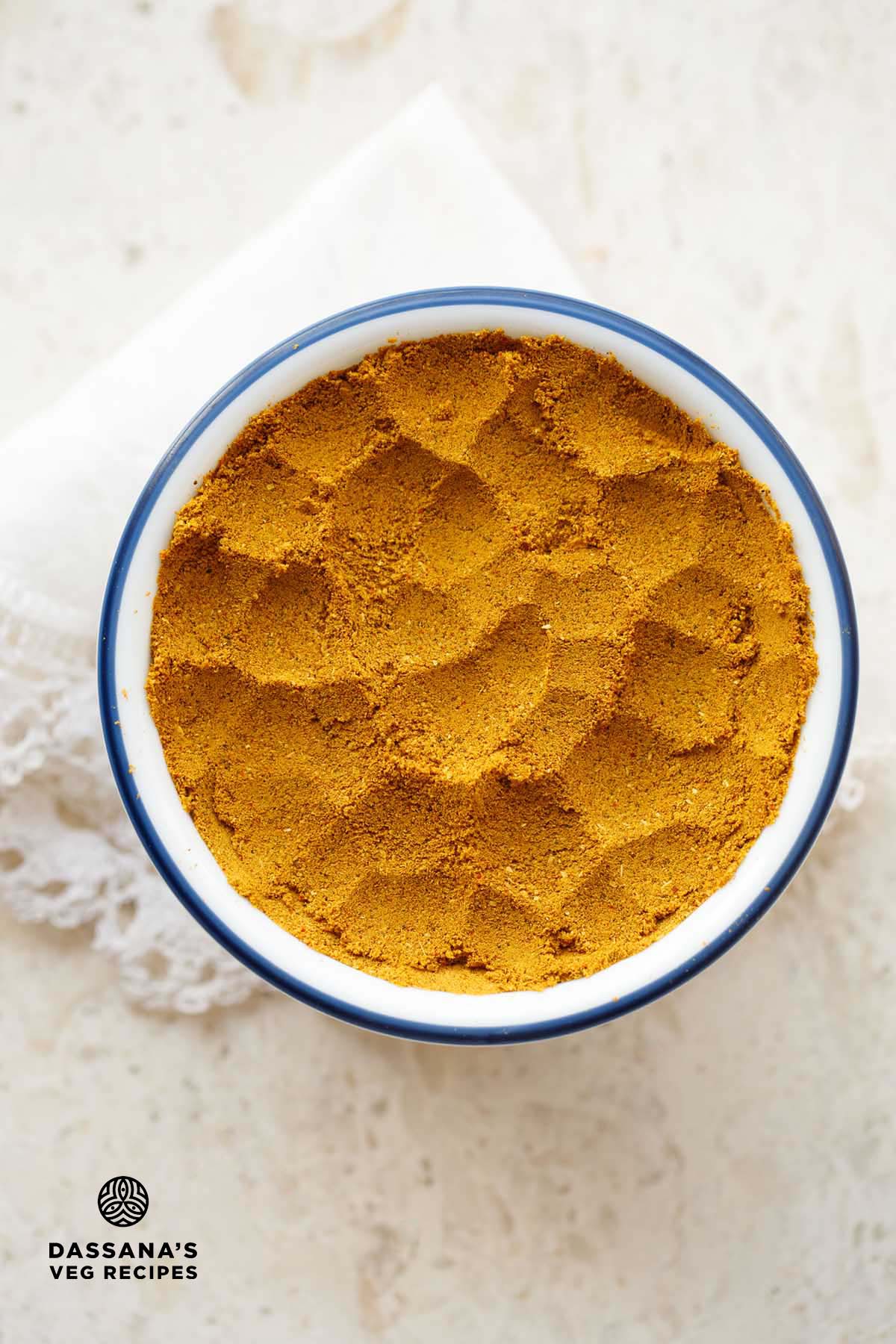
Yield & Storage
This homemade Sabji Masala makes about 75 to 80 grams (around ¾ cup) of spice blend. It’s enough for 3 to 4 weeks if you cook 4 to 5 vegetable or paneer dishes in a week.
Store it in a small airtight glass jar (100 to 125 ml capacity) away from heat, moisture, and sunlight. Avoid keeping it near the stove, where it’s exposed to steam or humidity.
In humid weather, it’s best to refrigerate the Sabji Masala in a tightly sealed container. It stays fresh for up to 1 month at room temperature and around 2 months if refrigerated.
Always use a clean, dry spoon to take the masala. For the best flavor and aroma, use the Sabzi Masala within a month of making it.
Serving Suggestions
Use 1 or 2 teaspoons of the Sabji Masala per dish serving 4 to 5 people. Add it either after sautéing onions & tomatoes or during the final stage of cooking.
You can add this homemade Sabji Masala to your everyday sabzis or comforting dals for a burst of flavor.
It blends beautifully into dishes like Aloo Gobi, Palak ki Sabji, Bhindi Masala, Mix Veg, or Matar Paneer.
Try sprinkling a little on Baingan Bharta, Paneer Angara, Aloo Matar or Paneer ki Sabji for that dhaba-style aroma.
It also tastes wonderful in Dal Fry, Chana Dal, or simple lentil recipes like Moong Dal and Whole Masoor Dal when you want a comforting North Indian touch.
Dassana’s Helpful Notes
- Roast the spices lightly: Over-roasting can make the masala bitter and harsh. Roast only until fragrant.
- Use fresh, high-quality spices: Always check expiry dates and avoid using old or stale spices.
- Inspect before using: Look for insects, mould, or moisture, especially in cinnamon, tej patta and coriander seeds.
- Grind only after cooling: Grinding warm spices can cause condensation and dull the flavor.
- Use a clean, dry grinder: Moisture in the jar can spoil the blend quickly.
- Stir often while roasting: Helps maintain even roasting and prevents scorching.
- Including salt: Adding salt is optional; if you do, reduce it while seasoning the sabzi.
- Perfect for North Indian dishes: Works best in onion-tomato-based gravies, dry sabzis, or paneer preparations.
Flavor & Customization Tips
- If using only ground spices: You can make this masala entirely with powdered spices instead of whole ones. Just reduce the quantity slightly, as store-bought ground spices are more concentrated and don’t need roasting.
- Skip black cardamom or mace: Omit these for a lighter, more neutral masala suited to everyday cooking.
- Garlic powder inclusion: Garlic powder is optional. It adds a light savory note to the masala, but you can skip it if you prefer a no-garlic spice blend. The flavor stays balanced even without it.
- Adjust spice intensity: Add more or fewer Kashmiri red chillies to control heat and color.
- Enhance flavor: Add a pinch of kasuri methi (dried fenugreek leaves) towards the end of cooking. It brings a warm, earthy aroma with a faint hint of bitterness that perfectly balances the spices and gives the dish that signature North Indian, restaurant-style flavor.
- Freshness tip: Grind small batches every 1 to 2 months to retain the aroma and natural essential oils.
Your Questions Answered
Can I use this masala for dal or paneer gravies?
Yes, you can add ½ to 1 teaspoon towards the end of cooking for a light North Indian flavor and aroma.
What’s the difference between Garam Masala and Sabji Masala?
Garam Masala is more intense and aromatic, while Sabji Masala is balanced for everyday vegetable dishes.
Can I skip dry mango powder (amchur)?
Yes. Add a few drops of lemon juice while cooking if you prefer mild tang.
My masala tastes bitter, why?
That happens if the spices are roasted too long or have got burnt. Even slight over-roasting can make spices like fenugreek, mustard, or cloves release a sharp bitter flavor. Always roast on low to medium-low heat, stirring constantly for even toasting and to prevent the spices from burning.
Step by Step Photo Guide Above
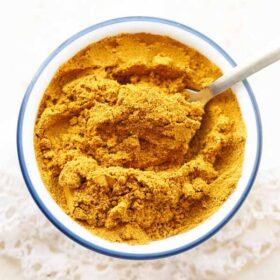
Homemade Sabji Masala Recipe
Ingredients
Whole Spices (To Roast)
- 4 tablespoons (20 grams) coriander seeds
- 2 tablespoons (14 grams) cumin seeds
- 1 teaspoon (3 grams) black peppercorns
- 1 tablespoon (7 grams) fennel seeds
- 6 cloves
- 4 green cardamoms
- 2 black cardamoms
- 2 inches cinnamon stick
- 2 tej patta (Indian bay leaf)
- 1 blade mace (javitri), optional
- 5 grams or 3 kashmiri red chillies
- 1 teaspoon (2 grams) caraway seeds (shahi jeera)
- ½ teaspoon (2 grams) mustard seeds – optional for slight pungency
- ½ teaspoon nutmeg – crushed
Powdered Spices (To Mix)
- 1 teaspoon dry ginger powder (saunth powder)
- 2 teaspoons (4 grams) dry mango powder (amchur)
- 1 teaspoon (3 grams) turmeric powder
- ¼ teaspoon asafoetida (hing)
- 1 teaspoon garlic powder – or use dried garlic flakes while roasting, optional
- 1 teaspoon (7 grams) pink salt or edible rock salt or regular salt – optional
Instructions
Roast The Spices
- Dry roast all the whole spices listed above over low to medium-low heat in a heavy kadai or a frying pan for 3 to 4 minutes until aromatic. Do not brown the spices.
- Remove pan from stovetop and place on the kitchen countertop.
- Add all the ground spices listed above including salt. Mix well. The ground spices will cook with the residue heat of the pan.
Make Sabji Masala
- Cool the spices at room temperature.
- Then grind them into a fine powder using a spice grinder or high-speed blender or a sturdy mixer-grinder.
Storage Suggestions
- Store Sabji Masala in a glass jar in a cool, dark place. Use within 1 month for best aroma and flavor.
- In a humid weather, it's best to store the Sabji Masala in the refrigerator.
- Always use a clean, dry spoon to take the masala. If moisture gets in, the masala can clump and lose flavor faster.
How to Use
- Add 1 to 2 teaspoons per sabzi dish (serving 4 to 5 people), preferably, after sautéing onions & tomatoes or during the final cooking stage.
- Best used in vegetable dishes like aloo gobi, bhindi masala, capsicum sabji, baingan bharta or curries like matar paneer, vegetable curry, arbi masala.
Notes
- Use fresh, high-quality spices: Always ensure that your spices are within their shelf life. Old or expired spices lose aroma and flavor.
- Check for insects or moulds: Before roasting, inspect whole spices like coriander, fennel, and cardamoms for any infestation or moisture damage.
- Roast gently: Dry-roast whole spices on low to medium-low heat only until fragrant as over-roasting makes them bitter.
- Cool before grinding: Let the roasted spices cool fully to prevent clumping and preserve natural oils.
- Grind in small batches: Make sure to grind in small portions, if you have a small grinder. Grinding too much at once can heat the masala and dull its aroma.
- Use a clean, dry grinder jar: Any moisture will spoil the spice mix faster.
- Store properly: Keep in an airtight glass jar in a cool, dark cupboard, away from sunlight, heat, or humidity.
- Keep away from the stove: Exposure to heat or steam can reduce its shelf life.
- Label and date the jar: Helps track freshness; ideally use within 1 month.
- Salt addition: Salt is optional, but if added, reduce the salt in your curry or sabzi when using this masala blend.
- Garlic Powder: It adds a mild savory flavor but is optional. Skip it for a simpler, no garlic version.
- Note that the approximate nutrition info is for the entire Sabji Masala made from this recipe.

